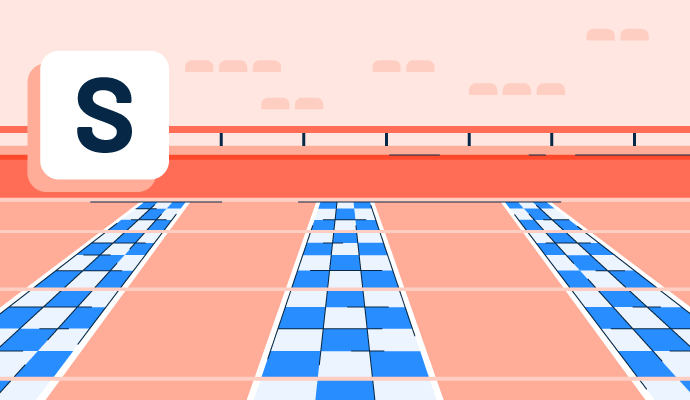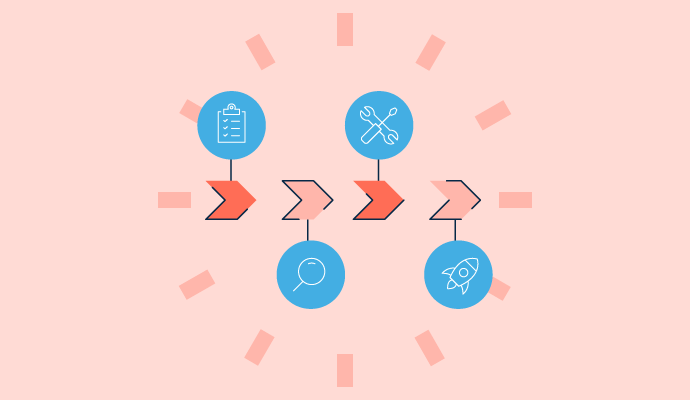What is a sprint?
Sprints are time-boxed periods when smaller teams focus on a single project or task type. A sprint typically lasts no longer than a month, although each company's time period is customizable. Teams plan and work on one sprint at a time; each sprint learns from the mistakes and successes of the previous ones.
Four roles exist within each sprint team: a product owner, a scrum or sprint master, and a developer or development team. It’s important to note that sprint roles don’t correlate to job titles; anyone can perform them regardless of position.
Teams that use work and projects in sprints often use project management software to organize their sprints and keep track of progress, blockers, and owners. Project management tools provide a host of features that make sprints easy, including workflow, resource management, scheduling, tasks, and reporting.
Steps involved in a sprint cycle
Sprint cycles rely on a repeatable process that’s easy to manage. Every sprint goes through a set cycle, which helps one sprint flow easily into the next.
Four steps are involved in every effective sprint:
- Planning. During this step, sprint teams should define the work that needs to be done. They should determine which project to concentrate on, when it should be finished, and who is responsible for each task. Planning often takes place during a single meeting involving all stakeholders.
- Working and implementation. This is the longest step in the cycle, as it’s when the actual work is done. During this phase, the scrum master may lead daily standups for team members to review progress and any obstacles. Standups or daily scrums normally last 15 to 30 minutes. The working stage of a sprint may involve multiple increments, which provide smaller stepping stones toward the sprint’s overall goal.
- Review, testing, and completion. When the work is completed, the review step of a sprint begins. How did the work turn out? Is it ready for release? If not, what needs to be fixed in the next sprint as a part of the backlog?
- Sprint retrospective. While the review step is related to the sprint’s work, the retrospective step reviews the efficiency and effectiveness of the recently completed sprint. Teams discuss problems and their solutions. Any improvements that can be implemented immediately influence the next sprint.
Once the retrospective of one sprint ends, the planning of the next sprint begins.
Benefits of a sprint
Sprints were created to allow teams to constantly ship new features or products instead of relying on one massive release per quarter or year. Because of their continuous and iterative nature, sprints greatly benefit the teams that subscribe to the work method. Some advantages are below.
- It’s easier to properly manage product backlog and technical debt.
- Projects can be deployed piece-by-piece and improved as sprints continue instead of releasing one potentially buggy or incomplete product or feature.
- Fixed time boxes encourage teams to focus on one problem and solve it faster.
- Short sprints offer more room for adaptation and iteration.
- Because sprint roles aren’t tied to job titles, some employees can lead projects they otherwise wouldn’t.
- It’s easier for teams to prioritize tasks instead of considering everything as a priority.
Best practices for sprints
Teams should follow these tips and best practices when conducting sprints to ensure success.
- Teams should listen to each other. A valuable part of the sprint and agile methodology is the room to address inefficiencies and inadequacies. Bring the team into that process and listen to their concerns; take action on the attainable ones immediately.
- Be realistic about the amount of work that can be completed within a single sprint. Set correct expectations for leadership and don’t overload the team with unnecessary work; normally, additional requests can wait until the next sprint.
- Focus on quality over speed. Although sprints are meant to move fast, they aren’t designed to produce poor, incomplete work. Make sure everyone on the sprint team knows the timeline, tasks, and expectations, so they don’t overwork themselves.
- Keep the company’s priorities, roadmap, and backlog in order. This makes sprint planning much easier.
- Allocate enough time for each sprint step, especially during the implementation stage. If possible, build padding time to protect the sprint team and give them more time to succeed.
Sprint vs. scrum
A sprint is a set period of time when a team focuses on one project.
A scrum is a core element of the agile methodology that uses sprints, among many other processes, to continuously ship new products and features.
Learn how to run a successful sprint, and take that knowledge to the next level with this definitive guide on project planning.

Whitney Rudeseal Peet
Whitney Rudeseal Peet is a former freelance writer for G2 and a story- and customer-centered writer, marketer, and strategist. She fully leans into the gig-based world, also working as a voice over artist and book editor. Before going freelance full-time, Whitney worked in content and email marketing for Calendly, Salesforce, and Litmus, among others. When she's not at her desk, you can find her reading a good book, listening to Elton John and Linkin Park, enjoying some craft beer, or planning her next trip to London.





















